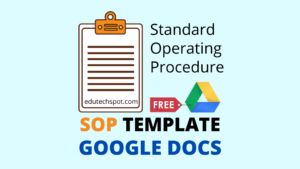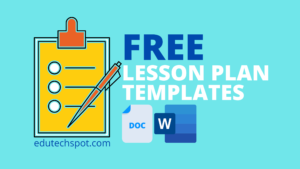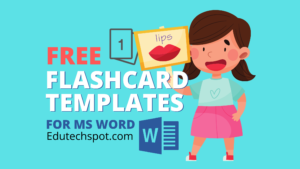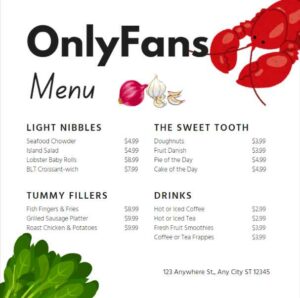Simple lesson plan template that you can edit easily. The followings are lesson plan format that are structured in simple way so that teachers find it easy to compose their own lesson plan.
Before you proceed, it is suggested that you check: Lesson Plan Template Google Docs.
Free Simple Lesson Plan Template:
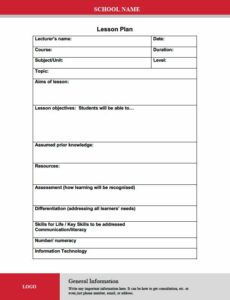
Parts: Topic, aims of lesson, lesson objectives (students will be able to … ), assumed prior knowledge, resources, assessment (how learning will be recognised), differentiation (addressing all learners’ need), Skills for Life / Key Skills to be addressed (communication / literacy), Information Technology. Flow: Content & Teacher Activity, Student Activity, Homework / Assignments set.
Source: Harrow College UK. https://www.harrow.ac.uk/
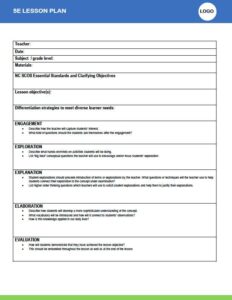
Parts: Essential Standards and Clarifying Objectives, Lesson Objectives, Differentiation strategies to meet diverse learner needs, 5E Lesson plan (Engagement, Exploration, Explanation, Elaboration, Evaluation).
Source: https://www.cs.duke.edu/
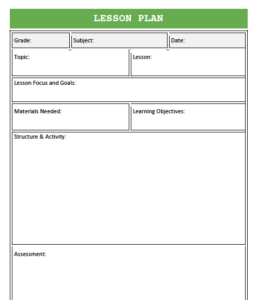
Parts: Lesson focus and goals, materials needed, learning objectives, assessment.
Source: https://edutechspot.com
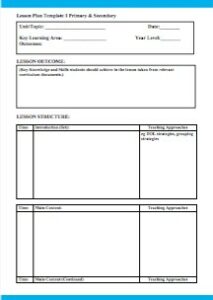
Parts: Lesson outcome, teaching approaches, resources, required equipment, safety consideration, materials, assessment, reflection.
Source: Charles Darwin University, Australia. https://www.cdu.edu.au
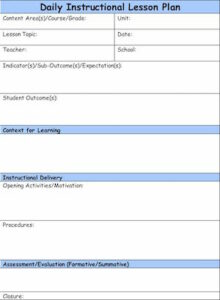
Parts: Daily instructional, Lesson Topic, Teacher, Indicators, sub-outcome, expectation, student outcome, context for learning, opening activities, motivation, procedures, Assessment or Evaluation (formative / summative), closure..
Source: Montgomery Country Public Schools. https://www.montgomeryschoolsmd.org
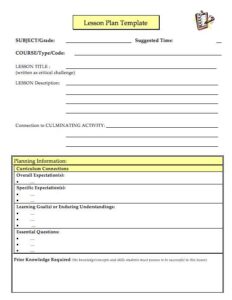
Parts: Lesson description, connection to culminating activity, Curriculum connections (overall expectation, specific expectation, learning goals or enduring understandings, essential questions), prior knowledge requirement, evaluation checklist, list of resources, teacher reflection.
Source: University of Toronto. https://www.oise.utoronto.ca
You can follow 6 basic and simple steps in preparing your lesson plan:
- Identifying the learning objectives,
- Planning the specific learning activities,
- Planning to assess student understanding,
- Planning to sequence the lesson in an engaging and meaningful manner,
- Creating a realistic timeline,
- Planning for a lesson closure.
Furthermore, you may need to pay attention to components of lesson plan. Many prominent teachers suggested using 5 components of a lesson plan: Objectives, Warm-up, Presentation, Practice, and Assessment.
In addition, you may need to consider the philosophy behind simplified lesson plan composition. The Simplified Lesson Organising Formula is exactly that: a series of stages that guide you through the process of planning your year, month, and weeks, and finally each day’s lessons.
Constructing continuity in your instruction is the goal of creating a lesson plan template. Your template and objectives may differ depending on your school, grade, and level. These are the most common templates used by instructors to create their daily lesson plans in the classroom.
The instructor must select three crucial components for effective lesson planning: the aim, the body, and a reflection. Experts advise teachers to design courses that allow students to study a variety of options, including incorrect responses, in order to properly comprehend why something is correct.
Tips:
You might think, How do I rapidly plan a lesson?
There are a few teaching practices that can help you get your lesson preparation done faster, according to the experience of several expert teachers: Start planning lessons from the beginning and get ready-to-use lesson plans. Collaborate with your colleagues in the classroom. Experiment with new ideas.
Lesson Plan Sequence:
Attract students’ attention so that they will look and listen when the educator delivers the learning material. Tell a tale or describe a problem that has to be solved. Use icebreaker exercises, current events, case studies, and YouTube videos, among other things. The goal is to swiftly pique the students’ interest in the subject. Use clickers and surveys to ask leading questions before a lecture, poll audience sentiment, or get an answer to a contentious subject.
Allow students to arrange their thoughts about what they are about to see, hear, and/or do by informing them of the objectives. Include learning objectives in lecture slides, the syllabus, and activity, project, and paper directions. Describe the expected level of performance. Describe the standard performance requirements.
Introduce fresh content: Use a variety of techniques, such as lectures, readings, activities, projects, multimedia, and so on. To minimize cognitive overload, organize and fragment the material. To aid in information memory, combine the information. Bloom’s Revised Taxonomy can be utilized to help you organize your lessons by breaking them down into levels of difficulty.
Provide direction: Inform students about ways for learning content and relevant resources. Students are less likely to waste time or grow irritated when they are given learning help because they are less likely to base their performance on inaccurate facts or poorly understood concepts.
As needed, provide instructional support in the form of scaffolds (cues, suggestions, prompts) that can be withdrawn once the student has mastered the activity or material. Demonstrate several learning tactics, such as mnemonics, concept mapping, role playing, and visualization. Make use of both examples and non-examples.
Allow students to put what they’ve learned into practice. Allow pupils to put what they’ve learned into practice in group or individual activities. Incorporate deep-learning questions, create references to prior knowledge, and encourage students to collaborate with their classmates. Students should be asked to memorize, reread, or reiterate what they’ve learnt. Encourage pupils to elaborate – urge them to elaborate or clarify specifics in their responses to make them more complex.
Provide fast feedback on students’ performance in order to evaluate and support learning. Consider using feedback at the group or class level (highlighting common errors, give examples or models of target performance, show students what you do not want)
Consider using peer-to-peer feedback. Students should be required to explain how they utilised feedback in subsequent works.
Test to see if the desired learning outcomes have been met in order to evaluate the success of the educational events. Performance should be measured against previously established goals. Exams/quizzes, written assignments, projects, and other evaluation methods should all be used.
Allow students to adapt material to personal situations to improve retention and transfer. By personalizing information, this improves retention. Allow students to connect course material to their own life experiences. Additional practice should be provided.
Want more free templates in Google Docs?


